Testing different levels of sigma for catch --- no variables locked
Summary
As the catch sigma, sc, grows, the following trend is fairly evident:
M grows, ultimately reaching its upper bound of 0.5 for sc = 0.2.
q becomes smaller
N0 becomes larger
The discrepancy between these estimates and the VPA estimates becomes larger
Experiments
No latent variables
 This experiment is included for convenience.
This experiment is included for convenience.
| Num. cohorts | Trajectories | Estimates |
| | 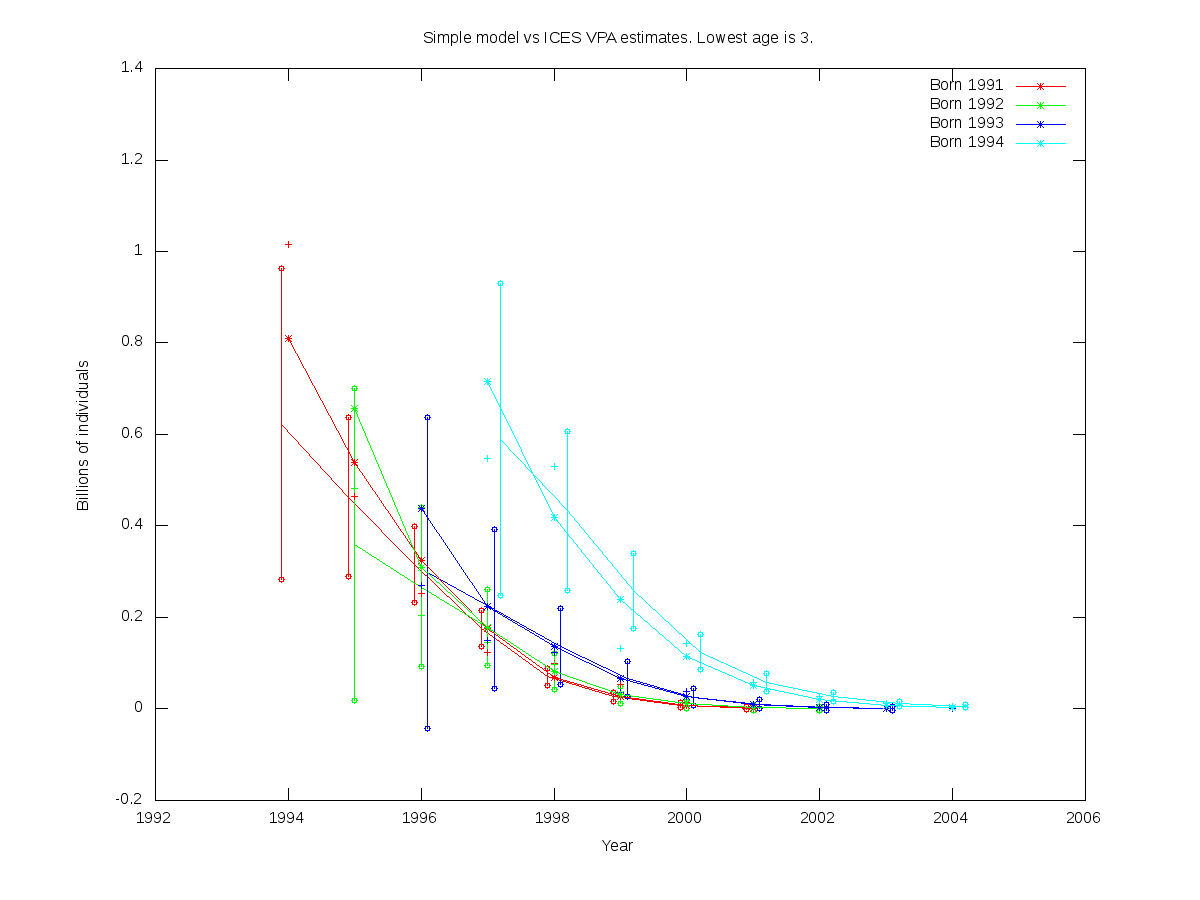 | Non-RE parfile:
- cod.par
../simple_model_sdreport/cod.par is the user-defined function defined from: ../simple_model_sdreport/cod.par
# Number of parameters = 7 Objective function value = -18.7801 Maximum gradient component = 0.000328611
# N0:
0.622791 0.359443 0.298084 0.589102
# q:
0.344332
# logs:
-1.08687795940
# M:
0.286208904677
|
sc = 0.05
| Num. cohorts | Trajectories | Estimates |
| 4 | 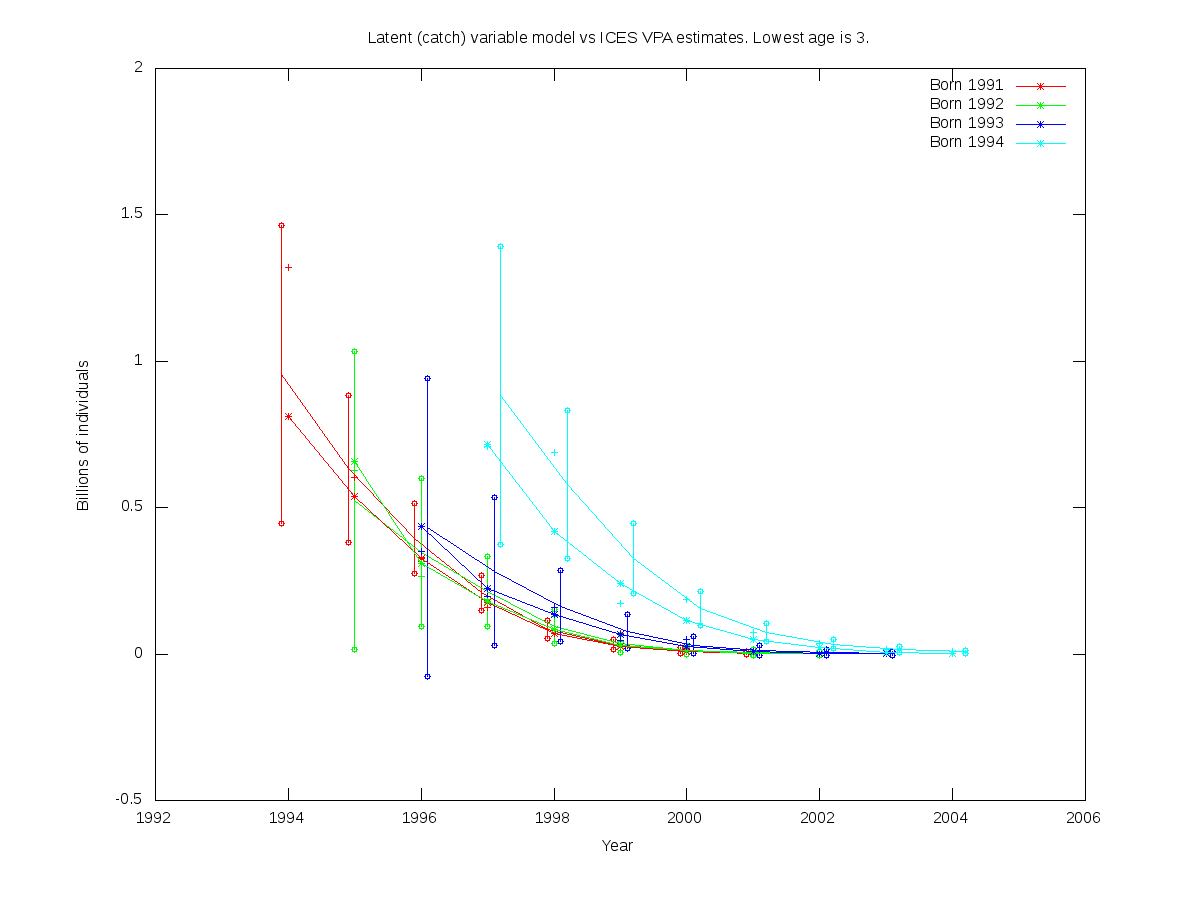 |
- cod.par
# Number of parameters = 7 Objective function value = -42.6068 Maximum gradient component = 2.91970e-05
# N0:
0.954542 0.525020 0.430878 0.882205
# q:
0.265073
# logs:
-1.03834928714
# M:
0.404604934881
# logscc:
-2.99570000000
# ce:
0.00247779228022 0.0229479340199 0.0505688023129 0.0348894489419 0.0918032224103 0.212086776154 0.191245255713 0.00335207864357 0.0208592944745 0.0594545624313 0.101789222254 0.0853961577455 0.179938079275 0.00514895739156 0.00328054977142 0.00437998603931 0.00576553600065 -0.0769757385253 0.0294089236518 -0.0305535704978 -0.0140065689668 4.29956956392e-05 0.0109425978175 -0.0559566234943 -0.0224908139433 -0.0140483408608 -0.00256440139985 -0.00370045247271
|
sc = 0.10
| Num. cohorts | Trajectories | Estimates |
| 4 | 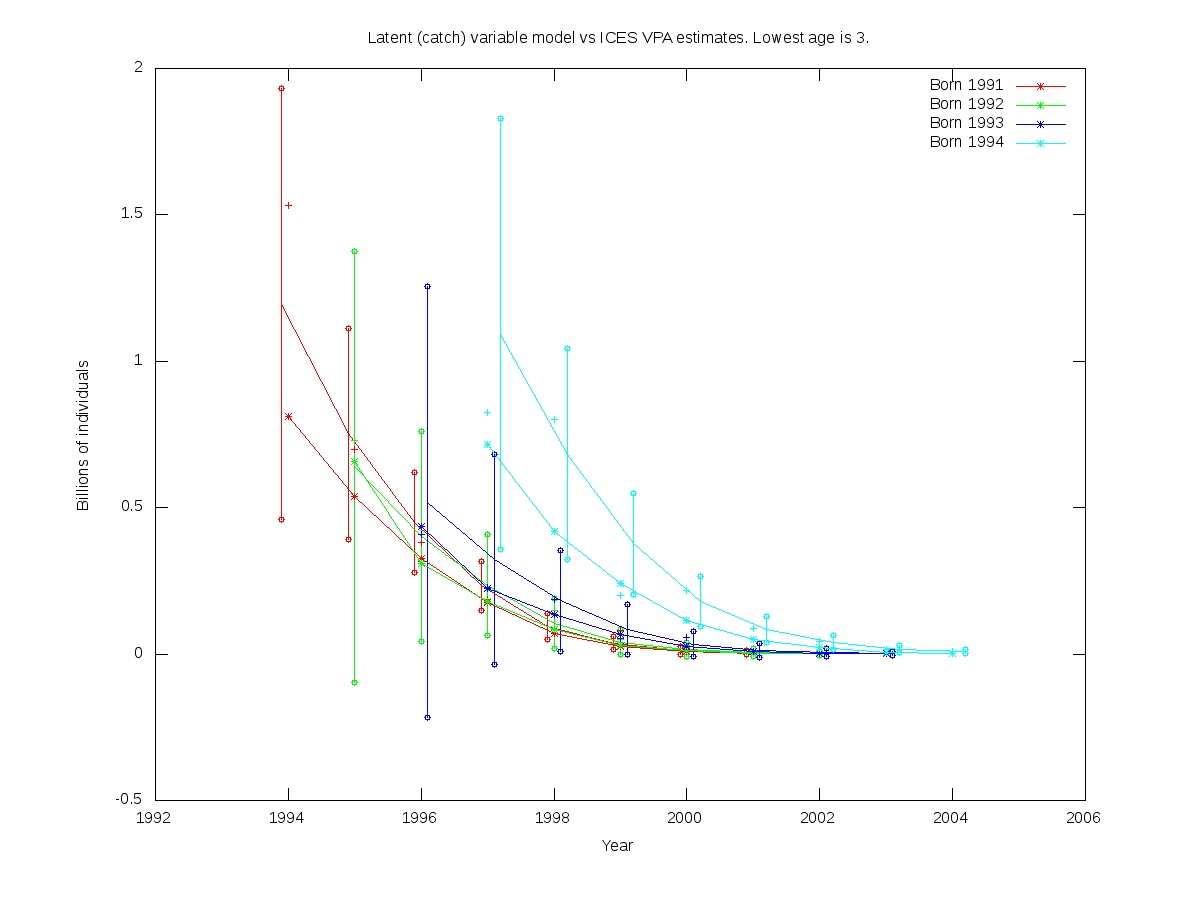 |
- cod.par
# Number of parameters = 7 Objective function value = -41.3791 Maximum gradient component = 3.12158e-05
# N0:
1.19545 0.639165 0.518724 1.09328
# q:
0.228269
# logs:
-1.01217107551
# M:
0.458196640288
# logscc:
-2.30260000000
# ce:
0.00299214635483 0.0278701196646 0.0618741327868 0.0383751969798 0.151822644707 0.365608394606 0.315531984532 0.00354899496011 0.0189950405372 0.0553077224029 0.153107532812 0.151731450319 0.326735539914 0.0241126794416 0.00287476031833 -0.00857989801320 -0.0134792904902 -0.137915370233 0.0555630741024 -0.0346120370533 -0.0130079769725 8.47659405510e-06 0.0155516659659 -0.0919629932316 -0.0385161866978 -0.0235292761542 -0.00422480068144 -0.00717389958011
|
sc = 0.15
| Num. cohorts | Trajectories | Estimates |
| 4 | 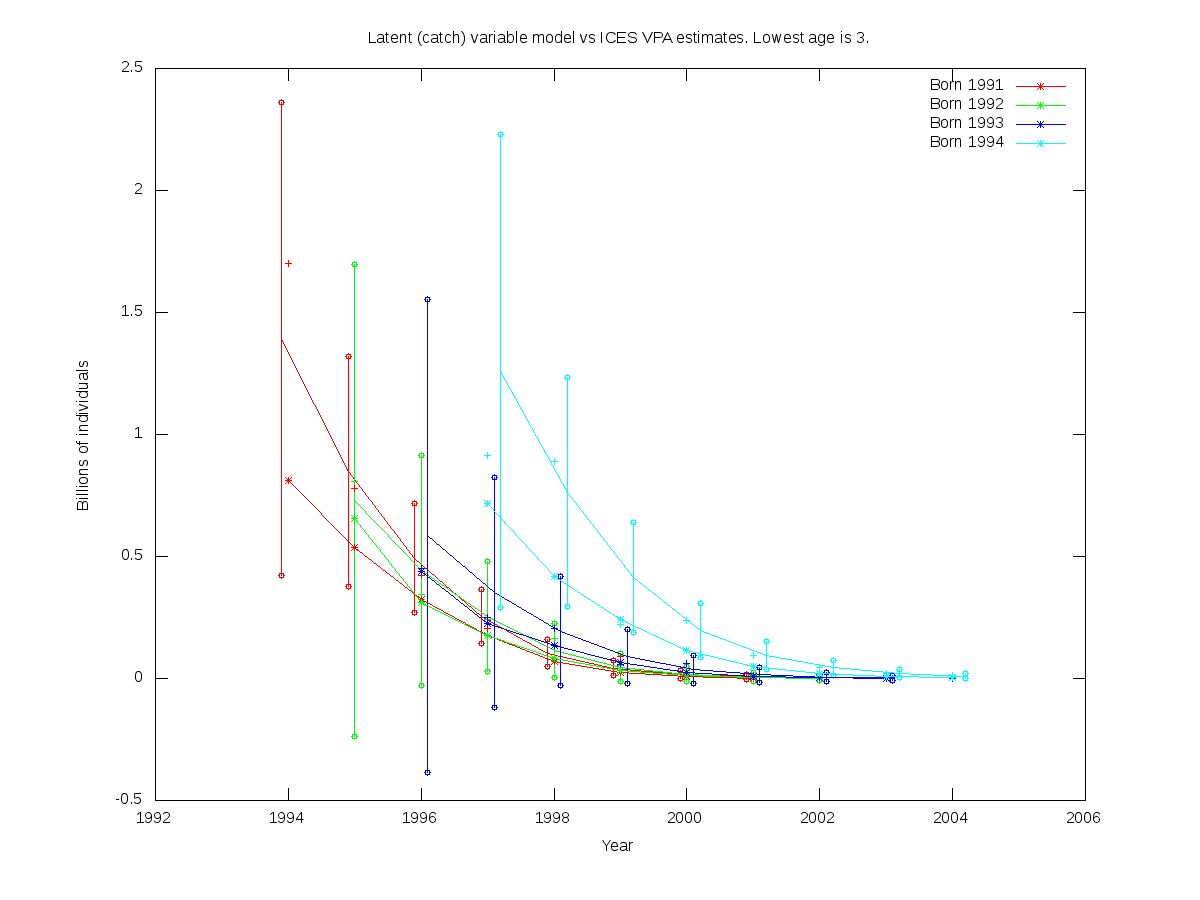 |
- cod.par
# Number of parameters = 7 Objective function value = -40.6063 Maximum gradient component = 1.19145e-05
# N0:
1.39098 0.729901 0.584592 1.26028
# q:
0.205649
# logs:
-0.998781332763
# M:
0.490865532859
# logscc:
-1.89710000000
# ce:
0.00317048912124 0.0291209453032 0.0634454016256 0.0313686081751 0.195132842454 0.493828424086 0.418259928564 0.00349535088274 0.0153966976922 0.0458988145034 0.194963732184 0.210402923647 0.459597257978 0.0424825792486 0.00219905797630 -0.0212146471716 -0.0299847853587 -0.182269221474 0.0844923100721 -0.0290441396331 -0.00763730108872 -0.000151418302052 0.0175157014252 -0.121951064410 -0.0528439366573 -0.0320061721550 -0.00613491712179 -0.0104048634647
|
sc = 0.20
 M reaches its upper bound, so the confidence intervals are not meaningful in this case.
M reaches its upper bound, so the confidence intervals are not meaningful in this case.
| Num. cohorts | Trajectories | Estimates |
| 4 | 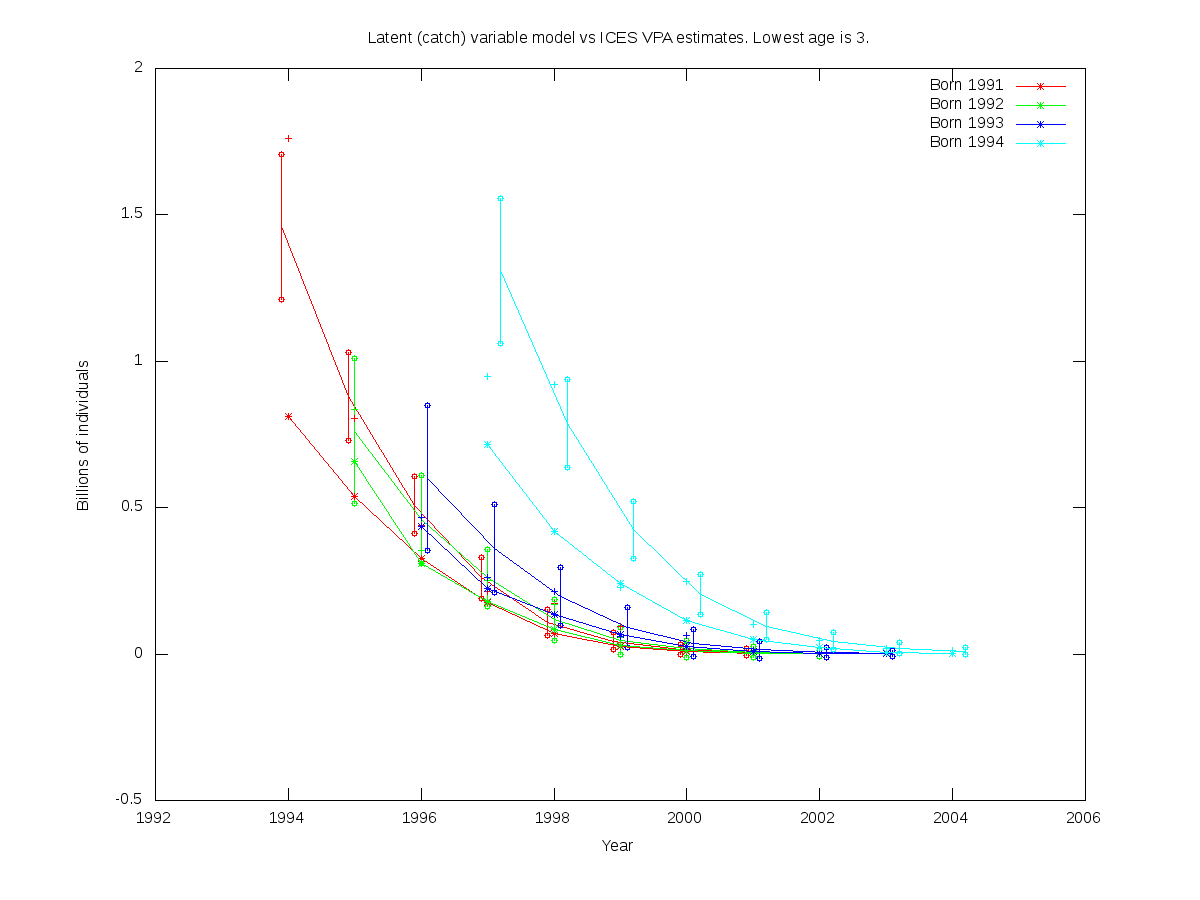 |
- cod.par
# Number of parameters = 7 Objective function value = -40.0734 Maximum gradient component = 8.87886e-05
# N0:
1.45886 0.761022 0.600593 1.30925
# q:
0.198675
# logs:
-1.00077721043
# M:
0.500000000000
# logscc:
-1.60940000000
# ce:
0.00363596210240 0.0328946839321 0.0690333423964 0.0219343626062 0.238833510443 0.647454025196 0.555654527656 0.00354347952971 0.0110982161633 0.0278238159678 0.226249885147 0.258422309992 0.605012616754 0.0523466267305 0.00165991134421 -0.0343769623289 -0.0465724924036 -0.231641419023 0.115770675459 -0.0281268857527 -0.00436850366929 6.94740923935e-05 0.0264814039215 -0.146575395945 -0.0591572604359 -0.0334358023913 -0.00183361619039 -0.0119811817291
|






